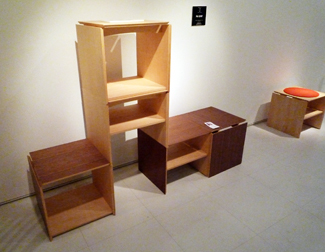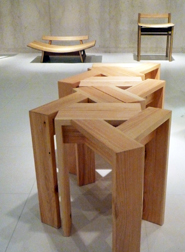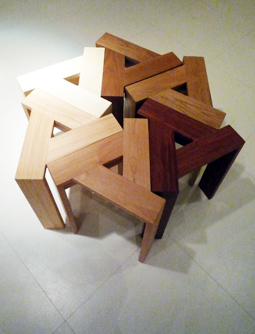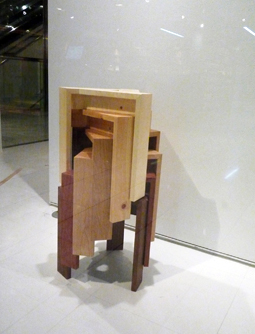 |
|
 |
"No Limit" multifunctional cubes.
|
|
"Spiral" stools fit together to form a bench, the "Monokokku" chairs beyond. |
|
"Structural Engineers x Furniture" is the first solo exhibition for Atsushi Nogimura at the Living Design Center Ozone gallery in Shinjuku. On display are several stools and chairs, tables and various multifunctional pieces, mostly in wood but also incorporating elements in steel, glass and even some leather details. Luckily, Mr. Nogimura happened to be in the gallery the day I visited and was willing to share his process with me. I could sense the sincere passion that he feels about his work. His English matched up nicely with my Japanese so together we had many laughs and understood each other perfectly.
Nogimura graduated from Nihon University with a degree in structural/architectural engineering. After years working as an engineer, he went on to specialize in woodworking at Saitama Technical School. He first started exhibiting his furniture in 2004 and has since shown in several exhibitions throughout Japan as well as the Copenhagen International Furniture Fair (2006) and 100% Design London (2008). His work is unfettered, modern and truly Japanese. That said, there is an unmistakable Danish influence.
The "No Limit" series is made of 40 x 40 cm cubical units in walnut veneer on ply. Right there in the gallery, Nogimura proudly demonstrated the endless ways in which these cubes may be configured and reconfigured: as shelves, side tables and a TV stand, a children's desk and chair; these can also incorporate lighting. His customized rabbet edge allows the units to interlock without sliding or slipping and without hardware to secure them. Nogimura approaches these challenges from an engineer's perspective.
Recently recognized with the Good Design Award (2008) and 100% Design Tokyo (2007), the three-legged "Spiral" stool is breathtakingly simple. When several "Spiral" stools are stacked as an objet d'art it is reminiscent of the 1933 Alvar Aalto E60 stool produced by Artek -- an homage perhaps, or just a happy accident. What is unique about Nogimura's "Spiral" is that numerous stools may be slipped together to form a slithering bench. When six of the stools are pushed tightly together they form an instant coffee table. "Spiral" is now in production and available in poplar, babinga, hinoki, maple, walnut, and Japanese oak.
Nogimura's economy of means is again demonstrated in the "Wave" knock-down stool -- a nomad's dream. It can be fully assembled in minutes, without any tools. The piece has two side panels which may be splayed inward or outward and which are secured by a steel rod at the base. The seat is made up of seven slats that fit elegantly into seven slots in each side panel. When two or more "Wave" stools with alternating splayed side panels are pushed together, the seats appear to form a gentle waving motion. The effect is magic, unfussy and not the least bit superfluous. The piece is currently in production and available in Canadian poplar and walnut.
"Monokokku," which means to be rendered from one piece, is a series of lightweight chairs, including one designed specifically for sitting Zen meditation. It is low and wide, and beautifully proportioned. The use is apparent from its form, but Nogimura gingerly demonstrated how one would use it, sitting in the lotus position.
"Patchwork" is a series that exploits the potential to pair different species of wood together. When I asked Nogimura whether he was concerned that the different woods might expand and contract at different rates, he revealed his engineering prowess: he had accounted for the varying expansion and contraction tolerances by only placing different species side-by-side, not end-to-end. Those that are end-to-end are actually the same species with different finishes. Just like a real patchwork quilt, what appears to be a nonchalant composition required some heavy calculations in order to be realized.
Nogimura explained that the dining table top was produced out of the pieces left over from his other works. Try to imagine this conversation in a mix of Japanese and English:
Nogimura (pointing to the table): "This is from garbage."
Nicolai: "It is reclaimed wood?"
Nogimura: "Other chairs' garbage."
Nicolai: "Oh, like scrap."
Nogimura: "Scrap?"
Nicolai: "Yes, we call leftover material scrap in English. I think that must be what you mean."
Nogimura: "Yes, scrap... rather, scrap plus alpha."
We laughed because we both know the experience of being inspired by the potential of our leftovers. Yet we always tend to need at least one additional ingredient, alpha.
Atsushi Nogimura is a designer to watch. He has an eye for the detail that comes to be expected in Japanese furniture design, but he also employs an economy of means that I admire. His work is pared down to the minimum and in some cases just this side of crude. No tricks, no fussy details, just pure, unadulterated, damn-why-didn't-I-think-of-that simplicity.
 |
|
 |
| Six "Spiral" stools together provide an instant coffee table (shown in various woods). |
|
"Spiral" as objet. |
|
|